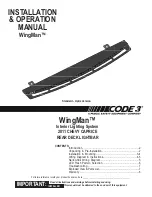
314
Operation
Tires and wheels
Tire inflation pressure changes by approxi-
mately 1.5 psi (0.1 bar) per 18°F (10°C) of
air temperature change. Keep this in mind
when checking tire inflation pressure
where the temperature is different from
the outside temperature.
Checking tire inflation pressure
Regularly check your tire inflation pressure
at least once a month.
Check and adjust the tire inflation
pressure when the tires are cold. The tires
can be considered cold if the vehicle has
been parked for at least 3 hours or driven
less than 1 mile (1.6 km).
If you check the tire inflation pressure
when the tires are warm (the vehicle has
been driven for several miles or sitting less
than 3 hours), the reading will be
approximately 4 psi (0.3 bar) higher than
the cold reading. This is normal. Do not let
air out to match the specified cold tire in-
flation pressure. Otherwise, the tire will be
underinflated.
Checking tire inflation pressure
manually
Follow the steps below to achieve correct
tire inflation pressure:
왘
Remove the cap from the valve on one
tire.
왘
Firmly press a tire gauge onto the
valve.
왘
Read tire inflation pressure on tire
gauge and check against the recom-
mended tire inflation pressure on the
Tire and Loading Information placard
on the driver’s door B-pillar
(
컄
page 307). If necessary, add air to
achieve the recommended tire inflation
pressure.
왘
Install the valve cap.
왘
Repeat this procedure for each tire.
Warning!
G
Follow recommend tire inflation pressures.
Do not underinflate tires. Underinflated tires
wear excessively and/or unevenly,
adversely affect handling and fuel economy,
and are more likely to fail from being over-
heated.
Do not overinflate tires. Overinflated tires
can adversely affect handling and ride
comfort, wear unevenly, increase stopping
distance, and result in sudden deflation
(blowout) because they are more likely to
become punctured or damaged by road
debris, potholes etc.
Do not overload the tires by exceeding the
specified load limit as indicated on the Tire
and Loading Information placard on the
driver’s door B-pillar. Overloading the tires
can overheat them, possibly causing a
blowout. Overloading the tires can also
result in handling or steering problems, or
brake failure.
i
If you have overfilled the tire, release tire in-
flation pressure by pushing the metal stem of the
valve with e.g. a tip of a pen. Then recheck the
tire inflation pressure with the tire gauge.
Summary of Contents for 2007 SLK 280
Page 2: ...SLK 280 SLK 350 SLK 55 AMG...
Page 21: ...20...
Page 23: ...22 At a glance Exterior view...
Page 25: ...24 At a glance Cockpit...
Page 27: ...26 At a glance Instrument cluster...
Page 33: ...32 At a glance Storage compartments...
Page 36: ...35 Getting started Unlocking Adjusting Driving Parking and locking...
Page 64: ...63 Safety and Security Occupant safety Panic alarm Driving safety systems Anti theft systems...
Page 173: ...172 Controls in detail Climate control...
Page 183: ...182 Controls in detail Automatic climate control...
Page 195: ...194 Controls in detail Audio system Operating and display elements...
Page 345: ...344...
Page 470: ......
Page 471: ......
Page 473: ......
















































